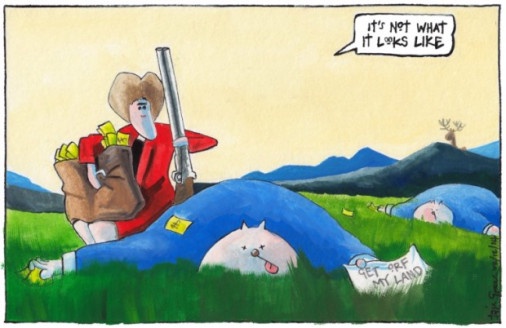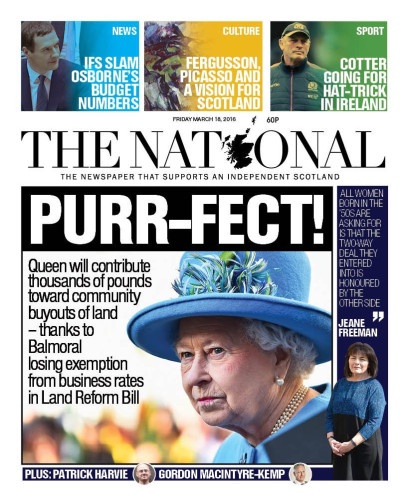This blog post explores Scotland’s newest land reform law. For those short on time, more selective and succinct coverage is available in this article in The Conversation.
On 19 April 2016, the Land Reform (Scotland) Act 2016 received Royal Assent. This final step of the law-making process signifies that the reigning monarch has rubber-stamped a statute passed by elected representatives, in this case Members of the Scottish Parliament. Those with a sprinkling of public law knowledge will know that the Queen does not readily withhold Royal Assent, so her personal views about a law or its potential impact on her are not normally scrutinised. In the wide press coverage of the run-up to and passage of this land reform legislation, there was a curious challenge to this norm. A tweet and an associated front page splash from the newspaper The National proclaimed the following: “Purr-fect news for communities as Queen’s new tax bill pays for buyouts”.

What was The National getting at? The first thing that might need an explanation is the “purr” reference, especially as the word “purr” does not actually feature in the news story (or, for that matter, the new statute). This is an oblique reference by the Scottish independence supporting newspaper to the fact the Queen apparently “purred” down the telephone to Prime Minister David Cameron in the aftermath of Scotland voting to remain in the UK on 18 September 2014. Now, though, the inference is that it is communities that will be purring, as they will benefit from any revenues that flow from the reinstatement of duties for certain land uses (namely shootings and deer forests). According to The National:
The Queen… will face an annual levy of thousands of pounds on her Balmoral property. Others who face paying the new tax include the Duke of Buccleuch, who is in charge of a sporting estate at Drumlanrig Castle in Dumfries and Galloway.
The Duke of Buccleuch (reported to be Scotland’s largest private landowner) and the Queen might make for handy, high-profile figures to be “land reformed”, but others without as much nobility or indeed land will be affected by this measure. Meanwhile, there are other measures in the Land Reform (Scotland) Act 2016 beyond the reintroduction of sporting rates which could also impact on a wide range of people.
So is the Land Reform (Scotland) Act 2016 “purr-fect” – sorry, time to scratch the cat imagery – perfect news for communities?
Before answering that, it should be recalled that this new statute is not the full story. This is not Holyrood’s first dalliance with land reform. In fact, we now have two Land Reform (Scotland) Acts, one from 2003 and a younger namesake from 2016.
The 2003 Act gave everyone the right to access Scotland’s land and inland waters, even without an owner’s prior consent, provided such access is taken responsibly and subject to certain exclusions relating to the character of land. It also provided for some rights of community acquisition, in rural areas and in the crofting areas of the north and west of Scotland.
Important as those innovations were, calls for further land reform in Scotland continued to be made from some sections of society. Such calls were answered in part by the Community Empowerment (Scotland) Act 2015. As its name suggests, that legislation aims to empower communities, which it does by giving them a number of entitlements to participate in local decisions and a new right of acquisition for abandoned, neglected or environmentally mismanaged land. It also widens the right of first refusal the 2003 Act introduced to rural Scotland by expanding it into Scotland’s cities.
Another answer to those calls is now found in the Land Reform (Scotland) Act 2016.
Cat-aloguing [sorry] the 2016 Act
This newest land reform statute contains a mix of measures. Two of those might lead directly to a change of landowner, either in terms of a community buying land to further the cause of sustainable development, or by allowing a secure agricultural tenant (more on such agricultural tenancies below) to buy land from her landlord in certain circumstances where that landlord is in material breach of a court order or an award made at arbitration.
Land reform can be about facilitating a change of ownership, but this land reform statute does far more than that. There are important changes that aim to make land reform a more permanent feature of the legal landscape, particularly a new non-party body called the “Scottish Land Commission”. When it is fully staffed and mobilised, the Commission will have a role in ensuring land reform stays in the foreground of Scottish policy, whilst maintaining proper oversight of the various measures that have been introduced. Further innovations include the promised “land rights and responsibilities statement”, which will be a standard against which landowners will be measured in future, and guidelines for engagement with local communities when important decisions are made by landowners.
A matter sometimes related to community engagement is whether a community knows who to engage with, as there have been occasions when an entity owning land in Scotland might not be entirely transparent (an issue which resurfaced with the recent “Panama Papers”). One part of the 2016 Act is designed to boost transparency. Together with a drive to complete the map-based Land Register of Scotland by 2024, new rules relating to the disclosure of who has a controlling interest of a landowning entity might mitigate such issues in future. Completely unrelatedly, but potentially leading to a similar effect, the UK Government has recently announced an anti-corruption push which will similarly lead towards transparency of landowning entities.
What else does the 2016 Act do? There is the already mentioned fiscal step towards land reform, changing the treatment of shootings and deer forests – or, to be exact, removing a relief that was conferred in the 1990s. Evidently this could have the effect of steering landowners towards a different use, depending on whether landowners are able to pay the rates, although some businesses may be able to benefit from other reliefs (such as those for small business) if they are eligible.
Deer management will also be affected by a regulatory as well as a fiscal change. Large areas of Scotland are given over to deer, which just about explains why deer feature in this newest of land reform statutes. An important ecological consideration is the lack of any natural predator, which necessitates human management of deer populations. Amongst other things, the new law will allow for the imposition of deer management plans in certain circumstances and will provide a power for the relevant authority to request information about a landowner’s planned management activities, rather than simply report on what has taken place (as was previously the case under the Deer (Scotland) Act 1996).
What if you want to go for a walk in an area where deer are found, or indeed anywhere else in the great outdoors? You still can. There are some technical reforms to the rights of access introduced by the 2003 Act also included in the 2016 Act, but these largely leave the existing rights as they were. (Incidentally, walking through an estate where legitimate deer management activities are taking place is probably not to be recommended.) There is also a technical reform to the regulation of “common good land” by local authorities, aimed at averting one of the issues that arose in relation to a new school in Portobello (analysed in this Edinburgh Law Review contribution (PDF)).
The last point to mention about the 2016 Act relates to its effect on the law of leasing, or at least two technical areas of rural leasing. The first affected area will be small landholder legislation, something of a niche area of landlord and tenant law. There is a commitment to review that legislation, with no indication yet of what changes might follow for Scotland’s relatively few remaining small landholders. Much more importantly, and in some cases controversially, there are a raft of reforms to the agricultural holdings regime.
Agricultural Holdings Reform
For many years, tenants with a certain type of agricultural lease have enjoyed something called security of tenure. This allows the tenant (and, in some cases, a successor or a transferee of an original tenant) to keep the lease of the rented property even after the original contractual term has finished, provided they have paid rent when due and generally maintained the property properly.
There has been a perception for a number of years that this system has not got the balance between the interests of tenants, landlords and indeed society as a whole quite right. The regime has contributed towards an environment where landlords often seek recovery of “vacant possession” of the land whenever they can, and traditionally this might have happened when there is a “break” in the succession of a lease. Aware of these issues, the Scottish Government appointed a specialist group to consider agricultural holdings legislation, which reported in 2015. The work of the group is reflected in the 2016 Act, which introduces two new types or rural leases – the repairing lease and the modern limited duration tenancy – and reforms the law relating to matters like rent review, assignation (transfer) and succession (inheritance).
Those changes to assignation and succession do not allow a lease to be passed to absolutely anyone, and as such the landlord still has a chance of getting the land back without being subject to a lease if there is no-one suitably close (in terms of relationship by blood or marriage/civil partnership) to the outgoing tenant to take it from them. That said, late in the parliamentary process a reform was made which might allow a secure lease to be passed to someone outwith those recognised proximate relationships. This controversial, and highly complex, reform will change the law in a way that makes it more difficult for a landowner to wash land clean of a lease. The current position is being changed to a position where an outgoing tenant can effectively cash-in the tenancy. The 2016 Act does still allow a landlord to get the land back, but not for free: it introduces a mechanism for the landlord to pay a sum to the tenant to buyout that lease. Where the landlord does not wish to buy it out, the tenant can then assign the lease to “an individual who is a new entrant to, or who is progressing in, farming”. As noted, this is a complex area, so it is not possible to explore this matter fully here, and there have been indications that landowners may challenge this particular reform on human rights grounds as an unfair interference with their property rights. Scottish legislation is susceptible to challenge in court, if it is not within devolved competence, for example by not being compatible with the European Convention on Human Rights. This was witnessed in the Salvesen v Riddell case (about an earlier agricultural holdings reform, which lumbered some landowners with a secure lease without compensation in a fashion found arbitrary by the courts) but not in the Pairc case (about a challenge to the crofting community right to buy (for value) in the Land Reform (Scotland) Act 2003, which was held to be a policy that was properly within a state’s margin of appreciation). If litigation was to follow in relation to the 2016 Act, suddenly the courts would have a role in the final approval of the law, which would mean the Queen’s Royal Assent would not be the final step after all.
Perfect legislation?
The 2016 Act covers a lot of legal ground. It will make a difference to landowners, land managers, communities, tenants and Scottish society as whole. That being said, it could have covered more ground still: for example, there have been suggestions about a cap on landownership above a certain level, restrictions on landholding entities registered outwith the EU, and the possible introduction of compulsory sale orders. None of those appear in the 2016 Act.
This suggests land reform activists might not think the 2016 Act is perfect after all, but what about landowners? Land reform is not exactly the kind of thing that will always please existing owners, but the one highlighted example about agricultural holdings reform demonstrates that they do have specific concerns which might yet lead to litigation.
Regardless of who is purring at the end of all this, the promised Scottish Land Commission, the preparation and ongoing review of measures to do with community engagement and land rights and responsibilities, the post-Holyrood election climate, and a new Cabinet Secretary for the Environment, Climate Change and Land Reform are all mixed together, it is clear that land reform is not going to retreat into the background any time soon. Indeed, the recent Holyrood election campaign demonstrated that many political parties are committed to further land reform. The fact that the Scottish National Party lost majority control of the Chamber means it will be looking for support from other political parties to implement its plans, which will have implications for any further land reform legislation.
No attempt has been made to contact the Queen to ascertain whether she is purring at the prospect of all of this, but one final feline observation might be made. Surprisingly, The National was not the first newspaper to juxtapose cats and Scottish land reform. The Scotsman got there first, with this cartoon from Iain Green appearing in December 2014.

Reports that Nicola Sturgeon has declared open season for fat cat lairds have not yet been confirmed.
Further analysis of some of the new measures can be found in this article in the Journal of the Law Society of Scotland, the professional journal of Scottish solicitors. That contribution looks at the new community right of acquisition, the framework for community engagement and the new Scottish Land Commission in more detail, but skims over deer management, the change to the fiscal treatment of shootings and deer forests, and agricultural holdings law.
Those wishing to read even more on this topic will find that land reform is something of a recurring feature at Malcolm Combe’s personal blog: basedrones.wordpress.com. He also has an article on redistributive land reform in the next issue of the Environmental Law Review, an open access version of which is available on (https://pure.abdn.ac.uk:8443/ws/files/65093352/Combe_The_Environmental_Implications_of_Redistributive_Land_Reform_ELR_accepted_manuscript.pdf?_ga=1.87681242.31230121.1375708526)
This blog post, by Malcolm Combe



